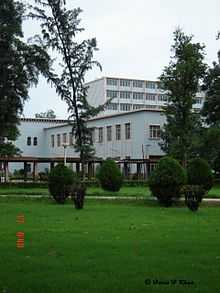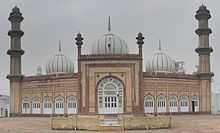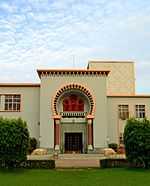Aligarh Muslim University
| Aligarh Muslim University | |
|---|---|
| अलीगढ़ मुस्लिम विश्वविद्यालय | |
|
The seal of the Aligarh Muslim University | |
| Motto |
Arabic: عَلَّمَ الاِنْسَانَ مَا لَمْ يَعْلَم 'allama'l-insāna mā lam ya'lam |
Motto in English | Taught man what he knew not (Qur'an 96:5) |
| Established |
1875 (as MAO College) 1920 (as AMU) |
| Type | Public |
| Endowment | $18.2 million[1] |
| Vice-Chancellor | Lt. General Zameerud-din Shah |
Academic staff | 2,000 |
| Students | 30,000 |
| Location | Aligarh, Uttar Pradesh, India |
| Campus | Urban 467.6 hectares (1,155 acres) |
| Acronym | AMU |
| Colors | |
| Nickname | AMU |
| Affiliations | UGC, NAAC, AIU |
| Website |
www |






Aligarh Muslim University (AMU) is a public university, funded by the central government of India originally established by Sir Syed Ahmad Khan as Mohammedan Anglo-Oriental College in 1875. The Mohammedan Anglo-Oriental College became Aligarh Muslim University in 1920.[2] The main campus of AMU is located in the city of Aligarh. Spread over 467.6 hectares in the city of Aligarh, AMU offers more than 300 courses in the traditional and modern branches of education. According to Times Higher Education, Asia Ranking 2014, AMU ranks 3rd among Universities in India.[3] The university comprises all castes, creeds, religions and genders.
History
It was established as Madrasatul Uloom Musalmanan-e-Hind in 1875–78,[4] The Anglo–Indian statesman Syed Ahmad Khan founded the predecessor of AMU, Muhammadan Anglo Oriental College ("MAO"), in 1877 having already established two schools.[5] He considered competence in English and "Western sciences" necessary skills for maintaining Muslims' political influence, especially in Northern India. Khan's image for the college was based on his visit to Oxford and Cambridge and he wanted to establish an education system similar to the British model.[5] HH Sir Mohammad Ali Mohammad and the Aga Khan III also played a major role in realising the idea of Sir Syed Ahmed Khan by collecting funds for building the Aligarh Muslim University[6]
In the beginning the college was affiliated with the University of Calcutta but became an affiliate of Allahabad University in 1885. Around 1900 efforts began to make the college its own university. Its range of courses was expanded and a girls school was added in 1907 before it became the Aligarh Muslim University in 1920.[5] The university was designed to train Muslims for government service in India and prepare them for advanced training in British universities.
In 1927, a school for the blind was established and, the following year, a medical school was attached to the university. By the end of the 1930s, the university had developed an Engineering faculty. Syed Zafarul Hasan, joined the Aligarh Muslim University in early 1900s as head of Philosophy Department, dean Faculty of Arts. He was a pro-vice chancellor before his retirement.
Before 1939, faculty members and students supported an all-India nationalist movement. After 1939, political sentiment shifted toward support for a Muslim separatist movement. University Students and faculty mobilised behind Muhammad Ali Jinnah and the University hence became an epicenter of Pakistan Movement.[7][8]
In late 2014 the university's vice-chancellor Zameerud-din Shah turned down a demand by female students to be allowed to use the Maulana Azad Library, which was male-only. Shah stated that the issue was not one of discipline, but of space as if girls were allowed in the library there would be "four times more boys," putting a strain on the library's capacity.[9][10][11] Although there was a separate library for the university's Women's College, it was not as well-stocked as the Maulana Azad Library.[9] National human resource and development minister Smriti Irani decried Shah's defense as "an insult to daughters."[10]
Responding to a petition filed by a Human Rights Law Network intern, the Allahabad High Court ruled in November 2014 that the university's ban on female students from using the main library was unconstitutional, and that accommodations must be made to facilitate student use regardless of gender.[11][12] The High Court gave the university until November 24, 2014 to comply.[12]
Campus
The college occupies over 467.6 hectares (1,155 acres) in Aligarh, Uttar Pradesh,
The faculty of social science established a Social Science Cyber Library which was inaugurated by the President of India on 27 December 2013.[13]
Ranking
In 2012, the university was ranked 5th by India Today.[14] In 2013, the University ranked 9th in the top 10 higher education institutions in India by Times Higher Education World University Rankings.[15] In 2015 the National Assessment and Accreditation Council rated the school 3.35/A.[16]
Vice-chancellors
The vice-chancellors of Aligarh Muslim University are:[17]
- Mohammad Ali Mohammad Khan[18][19] 20 December 1920 – 28 February 1923
- Mohammad Muzammillah Khan Serwani[20][21] (Acting) 1 March 1923 – 31 December 1923 and 1 January 1927 – 8 February 1929
- Sahebzada Aftab Ahmad Khan 16 February 1924 – 15 November 1926
- Shah Mohammad Sulaiman Ahmad(Acting) 9 February 1929 – 19 October 1929 and 30 April 1938 – 31 March 1941
- Ross Masood 25 January 1930 – November 1933
- Mohammad Ismail Khan 1 October 1934 – 12 April 1935 and 17 October 1947 – 29 November 1948
- Ziauddin Ahmed[22] 13 April 1935 – 29 April 1938; 24 April 1941 – 23 April 1947
- Zahid Hussain 24 April 1947 – 7 August 1947
- Zakir Hussain 20 November 1948 – 15 September 1956
- Bashir Hussain Zaidi 7 October 1956 – 6 November 1962
- Badaruddin Taiyabji 8 November 1962 – 28 February 1965
- Ali Yawar Jung March 1965 – January 1968
- Abdul Aleem 6 January 1968 – 3 January 1974
- A. M. Khusro 20 December 1974 – 12 December 1978
- Syed Hamid June 1980 – 26 March 1985
- Syed Hashim Ali 8 April 1985 – 4 October 1989
- Mohammad Naseem Faroqui 15 October 1990 – 15 December 1994
- Mahmoodur Rahman 1 May 1995 – 1 May 2000
- Mohammad Hamid Ansari 28 May 2000 – 31 March 2002
- Naseem Ahmad 8 May 2002 – 17 April 2007[23]
- P. K. Abdul Aziz 18 May 2007 – 17 January 2012[24][25]
- Zameerud-din Shah[26] 12 May 2012[27]
Notable alumni
Alumni of the university are popularly known as Aligarians (the more generic Aligarhiya is used to refer to inhabitants of Aligarh who have not studied at AMU.)[28]
References
- ↑ "Aligarh Muslim University, BHU welcome budgetary allocations". The Times of India. Retrieved 23 May 2013.
- ↑ "Aligarh Muslim University". Amu.ac.in. Retrieved 8 July 2012.
- ↑ "Academic Progression". Aligarh Muslim University.
- ↑ "Aligarh" in Chambers's Encyclopædia. London: George Newnes, 1961, Vol. 1, p. 267.
- ↑ 5.0 5.1 5.2 "AMU History". Aligarh Muslim University. Retrieved 30 March 2014.
- ↑ Express Tribune. "To sir with love: Aga Khan III – a tireless advocate for female education".
- ↑ Mushirul Hasan, "Nationalist and Separatist Trends in Aligarh, 1915–47," Indian Economic and Social History Review, (January 1985) 22#1 pp 1–33
- ↑ Zakir Ali Khan, an alumni of AMU, in an Interview with The Dawn, Pakistani newspaper
- ↑ 9.0 9.1 Eram Agha, Girls in AMU library will ‘attract’ boys: VC. The Times of India, November 11, 2014.
- ↑ 10.0 10.1 Irani slams AMU V-C over women in library remark. Hindustan Times, November 11, 2014.
- ↑ 11.0 11.1 Allow entry of girls inside library: Allahabad High Court to AMU. Deccan Chronicle, November 25, 2014.
- ↑ 12.0 12.1 India court library ban on women 'unconstitutional'. BBC News Online, November 14, 2014.
- ↑ "President of India inaugurates XXXVII Indian Social Science Congress". Batori.in. 27 December 2013. Retrieved 10 April 2014.
- ↑ "Back Where It Belongs: AMU at 5th spot on India Today Universities Rankings 2012". Indiatoday.intoday.in. 18 May 2012. Retrieved 21 February 2013.
- ↑ "India's top 10 higher education institutions". The World University Rankings. 4 March 2013. Retrieved 9 March 2013.
- ↑ "5th Meeting of the Standing Committee (3rd March 2015): List of Institutions Recommended For Accreditation by NAAC (1st Cycle)" (PDF). National Assessment and Accreditation Council.
- ↑ "AUM VC's List – DeedahwarNewsViews". Sites.google.com. Retrieved 8 July 2012.
- ↑ Aligarh Movement. "H.H. Sir Mohammad Ali Mohammad, Khan Bahadur, Raja Mahmudabad". Aligarh Movement. Retrieved 8 July 2012.
- ↑ "Welcome to Basaha Estate". Basahaestate.in. Retrieved 8 July 2012.
- ↑ abdullah (10 January 2012). "Former AMU Pro-Chancellor Passed Away | My AMU | Aligarh Muslim University – My Way". Myamu.in. Retrieved 8 July 2012.
- ↑ http://mail.sarai.net/pipermail/reader-list/2011-January.txt
- ↑ ":: Ziauddin University ::". Zu.edu.pk. Retrieved 8 July 2012.
- ↑ http://ncm.nic.in/naseem%20ahmad.html
- ↑ "Abdul Azis VC of Aligarh Muslim varsity". The Hindu (Chennai, India). 19 May 2007. Retrieved 10 July 2013.
- ↑ "Aligarh V-C's tenure ends". The Hindu (Aligarh). 18 January 2012. Retrieved 10 July 2013.
- ↑ "Zameeruddin Shah is new Aligarh Muslim University vice-chancellor". Times of India. 12 May 2012. Retrieved 8 July 2012.
- ↑ "Naseeruddin Shah's brother appointed Aligarh Muslim University Vice-Chancellor". NDTV.com. 11 May 2012. Retrieved 8 July 2012.
- ↑ "Test for admission to courses in AMU centre". The Hindu (Chennai, India). 29 March 2011.
Further reading
- Mushirul Hasan: "Nationalist and Separatist Trends in Aligarh, 1915–47" in Indian Economic and Social History Review (Jan 1985), Vol. 22 Issue 1, pp 1–33
- Gail Minault and David Lelyveld: "The Campaign for a Muslim University 1898–1920" in Modern Asian Studies (March 1974) 8#2 pp 145–189
External links
| Wikimedia Commons has media related to Aligarh Muslim University. |
| ||||||||||||||||||||||||
| ||||||||||||||||
| ||||||||||||||||||
| ||||||||||||||||||||||||||||||||||||||||||||||||||
| ||||||||||||||||||

